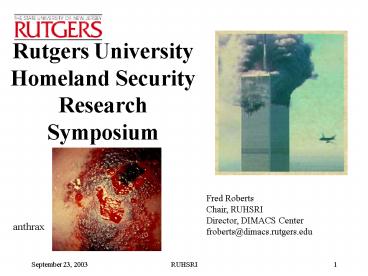Rutgers University Homeland Security Research Symposium - PowerPoint PPT Presentation
Title:
Rutgers University Homeland Security Research Symposium
Description:
The fundamental technologies underlying our economic ... Christine Spassione. Organizing Committee: Margaret Brennan. Nabil Adam. Stan Dunn. Rick Mammone ... – PowerPoint PPT presentation
Number of Views:69
Avg rating:3.0/5.0
Title: Rutgers University Homeland Security Research Symposium
1
Rutgers University Homeland Security Research
Symposium
Fred Roberts Chair, RUHSRI Director, DIMACS
Center froberts_at_dimacs.rutgers.edu
anthrax
2
- Concerns about security
- Physical safety
- Transportation
- Food and water supply
- The fundamental technologies underlying our
economic system (communications, computing) - The very working of our modern society
- RUHSRI is aimed at coordinating homeland security
research at Rutgers.
3
RUHSRI was founded in May 2003. It resulted from
a series of meetings following the September 11
attacks meetings were aimed at sharing
information about research efforts at
Rutgers. Thanks to the initiative of Office of
VP for Academic Affairs Office of Federal
Relations Office of Research and Sponsored
Programs
4
Existing efforts at Rutgers in homeland security
research are widespread and impressive. Many
could lead quickly to practical RD programs and
new business development. They could easily form
the basis for a dozen major initiatives. We
present a selection of relevant current research.
5
SURVEILLANCE/DETECTION
- Biosurveillance/chemosurveillance
- Adverse event/bioterrorist attack detection
- Pathogen detection (Terahertz (THz) wave imaging
detecting airborne anthrax particles) - Weapons detection/identification (dirty bombs,
plastic explosives) - Analysis of massive, high speed data for
anomaly/outlier detection - Intelligent question answering (interface between
the intelligence analyst and data) - Computational/mathematical models in epidemiology
6
SURVEILLANCE/DETECTION-II
- Biometrics
- Face, gait, voice, iris recognition
- Non-verbal behavior detection (lying or telling
the truth?) - Text Surveillance
- Monitoring message streams for new events
- Statistical methods in textual analysis
7
SURVEILLANCE/DETECTION - III
- Sensors
- Bioterrorism sensor location
- Sensor networks to monitor bio/chem hazards
- Design of sensors (high sensitivity ZnO sensors
UV detection devices for bio-detection nanoscale
semiconductor sensors)
BASIS bioterrorism sensor
8
PROTECTING THE CRITICAL INFRASTRUCTURE
- Communication Security
- Network security, mobile and wireless security
- Secure communication through tunable adaptive
filters - Secure communication through low bit-rate coding
- Sharing data
- Information privacy
- Identity theft
- Secure e-commerce
9
PROTECTING THE CRITICAL INFRASTRUCTURE II
- Transportation and Border Security
- Transportation infrastructure security (airports,
marine terminals, transit hubs) - Pattern recognition for machine-assisted baggage
searches - Statistical analysis of flight/aircraft
inspections - Port-of-entry inspection algorithms
- Border security (decision support software)
- Vessel tracking for homeland defense
- Pipeline security
10
PROTECTING THE CRITICAL INFRASTRUCTURE III
- Food and Water Supply Security
- Regional drinking water security consortium
- Food and water biosecurity initiative
- Remediating contaminated water
- Bioterrorism training (environment public
health) - Agroterrorism Using economic weapons to prevent
agroterror attacks
11
RESPONDING TO AN ATTACK
- Exposure/Toxicology
- Modeling dose received
- Rapid risk and exposure characterization
- Toxicology of WMDs
- Evacuation
- Simulating evacuation of complex transportation
facilities - Plume modeling to determine areas of risk
- Handling patients before ER admission.
12
RESPONDING TO AN ATTACK - II
- Cleanup
- Monitoring and control for chem/bio attack
emergency response - Air and water purification systems
- Decontamination of areas affected by chem/bio
weapons - Emergency scene management
13
RESPONDING TO AN ATTACK - III
- Emergency Communications
- Infostations for rapid wireless communication for
first responders - Rapid networking at emergency locations
- Risk communication methods
- Rapid telecollaboration
- Legal Responses to Terrorism
- Analysis of laws to control or suppress terrorism
14
STRENGTHS AT RUTGERS
- Many of the projects described are already
receiving external funding. - There is already substantial partnership with NJ
industry (small and large).
15
Partial List of Partners at Rutgers
Departments. Computer Science, Chemistry,
Physics, Statistics, Mathematics Centers CAIP
(Advanced Information Processing), DIMACS
(Discrete Math CS), EOHSI (Environmental
Occupational Health Safety), WINLAB (Wireless
Networking), Institute for Marine and Coastal
Studies, Rutgers Center for Study of Public
Security, CIMIC (Information Management,
Integration Connectivity), Waksman Institute
for Microbiology, Computational Biomedicine
Imaging and Modeling, CAIT (Advanced
Infrastructure Transportation) Schools
Engineering, SCILS (Information and Library
Sciences), Cook College and NJ Agricultural
Experimental Station, Business School, Law
School, Criminal Justice
16
Current external funding for Homeland Security
Research at Rutgers (without a coordinated
effort) is 54M
17
PROJECTS OF RUHSRI
- Database of researchers/research at Rutgers
- Enhancing collaborations within RU and with other
universities and government and industry - Leveraging individual efforts (e.g., CJGED
proposal, DHS university centers of excellence
proposal) - Taking a leadership role at Rutgers and NJ
- Todays symposium
- Symposium on homeland security research at NJs
research universities October 29, at Rutgers
18
TODAYS AGENDA
- Short talks quick overviews
- Posters and demonstrations In lobby and during
lunch in 4th floor conference room - Lunch fourth floor lounge (with DIMACS Workshop
on Large-Scale Internet Attacks) - Discussion groups What should we be doing and
what can Rutgers do? See charge. - Reports from discussion groups.
- Networking reception.
19
- ORSP Mike Breton
- Staff
- Leslye Lowen
- Christine Spassione
- Organizing Committee
- Margaret Brennan
- Nabil Adam
- Stan Dunn
- Rick Mammone
- Bob Snyder































